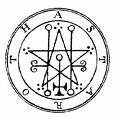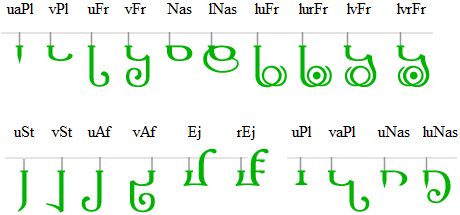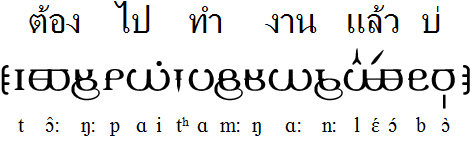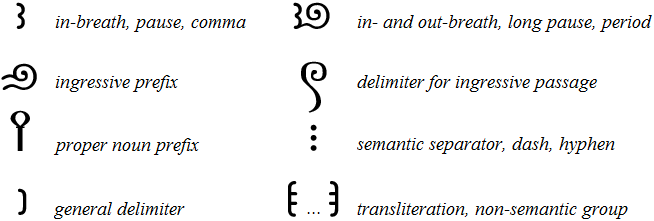This is a script system for SIGIL, an a priori language being developed by the author since 2006. The acronym stands for Scenic Intuitive Glomerative Ideal Language, and the system for writing it presented here is the 25th edition (very similar to the previously-published 24th edition), stable enough to be used for transliteration of other languages (such as English) until final release of SIGIL itself in the near future. There have been a number of other scripts since this one. And the language is since finished.
Notable Features
- shapes based on phonological concepts and metaphors
- phonetically consistent alphabet
- large inventory of phonemes
- easy to write
- glyphs are assembled as if from a “kitset”
- the philosophy of SIGIL is to represent things in as intuitive a way as possible, reflecting the world in direct metaphors of speech and writing
1 Consonants
1.1 Region
The shapes of the consonants derive from perceived features of phonemic production. There are nine primary shapes which form the top part of a consonant glyph; these relate to locations in the mouth. To these, modifier strokes and tails are added (see below). There is a special glyph for the flap. For vowels, there are bowls upon which diacritics sit (see later); one bowl-type makes a plain vowel, the other makes a round vowel.
The consonant regions are labeled for convenience:
- P – bilabial
- T – dental
- S – alveolar (sibilants)
- ss – alveolopalatal (sibilants)
- R – retroflex
- K – palatal, front velar
- L – lateral (sibilants)
- Q – rear velar
- H – glottal
The P base is soft, bulging, puffy; the T base represents a small tapper; the S and ss bases are extensions of the T base; the R base represents a soft springy beater; the K base represents a sharp cut high on the palate; the Q base is similar, but deeper; the H base represents a deep swirl (the words spirant and spiral are related). The glyph for alveolar or retroflex tap (flap) is derived from the retroflex base.
1.2 Articulation
A modifier is attached to the consonant region sub-glyph, to specify the manner of articulation:
There are Plosives, Fricatives, Nasals, Stops, Affricates and Ejectives. In the chart, the label prefixes are:
- l – long
- u – unvoiced
- v – voiced
- r – rounded
- a – aspirated
Here are the most common phonemes in the P series. Note how the stoppage phonemes have a reversed head.
Here are some of the sibilant series, and the H series. The L base comes from the vowel shape (see below).
2 Vowels
The base shape for all vowels (and semivowels) is a resonating bowl, shown in red in the chart above. The most open phonemes have no additional marking, but the others have a modifier above. Rounded vowels add a rounding closure to the bowl. If two or more vowels are produced in sequence, the bowls are joined to form a continuous base glyph, upon which the modifiers float. Three of the vowel modifiers may be joined to their bowl if in solo or final position.
The I modifier represents a small tight effect; the E modifier represents a free outward effect; the U modifier represents a channel; the L modifier represents a raised forking effect, and the R modifier represents a soft rolling effect. Plosives may have an inherent schwa, but an explicit vowel mark is available.
Initial vowels are usually preceded by a glottal plosive, unless a gradual onset is desired. Gradual onset is the case especially for initial /j/ and /w/, which are otherwise considered to be the same as /i/ and /u/.
3 Tones
Tones are used in SIGIL mainly for syntactic purposes. Each affected vowel is marked with either a high tone (a line representing a raised level of liquid in the bowl and consequent higher pitch), or a low tone (a vertical line below). In combination, falling and rising tones may be formed. Here is an example of transliterating a passage of Thai which shows use of tones, as well as unvoiced unaspirated plosives:
4 Numerals & punctuation
The numerals (except for the figure zero) are simply formed by joining the relevant numbers of imaginary dots with the least number of strokes. There are glyphs up to 15, to allow consistent counts in hexadecimal; the extra shapes also bear some resemblance to the standard ABCDEF hex letter forms.
Punctuation and other markings are fairly straightforward. In and out breaths are written explicitly and translate roughly into standard comma etc. The proper noun prefix is derived from the Egyptian ankh symbol of life. The transliteration brackets represent lips with teeth, and the mere sound which emerges from between them.
5 Examples
5.1 This is really just a transliteration, but it shows how the SIGIL script runs. These are famous lines from Shakespeare; can anyone identify them?
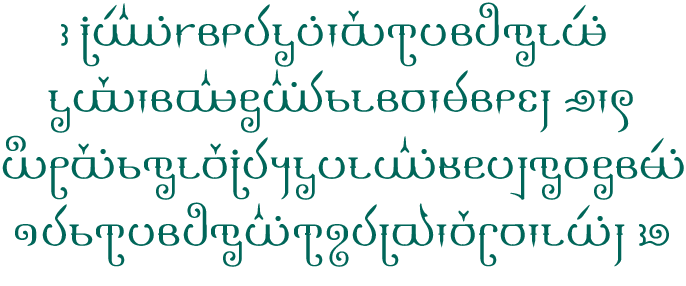
5.2 Another transliteration, Article 1 of the Universal Declaration of Human Rights. There is an alternative U modifier (horizontal bar) used in this older, 24th edition font:

“All human beings are born
free and equal in dignity and
rights. They are endowed with reason
and conscience and should act
towards one another in a
spirit of brotherhood.”
An earlier version of this page can also be found on
Omniglot.
